Alf Milward — The Toffees’ First Great Left Winger of the League Era
Everton's original great left-sided partnership was formed by the contrasting but complimentary attributes of Edgar Chadwick and Alf Milward, a huge factor in the Club landing its very first Football League title in 1891
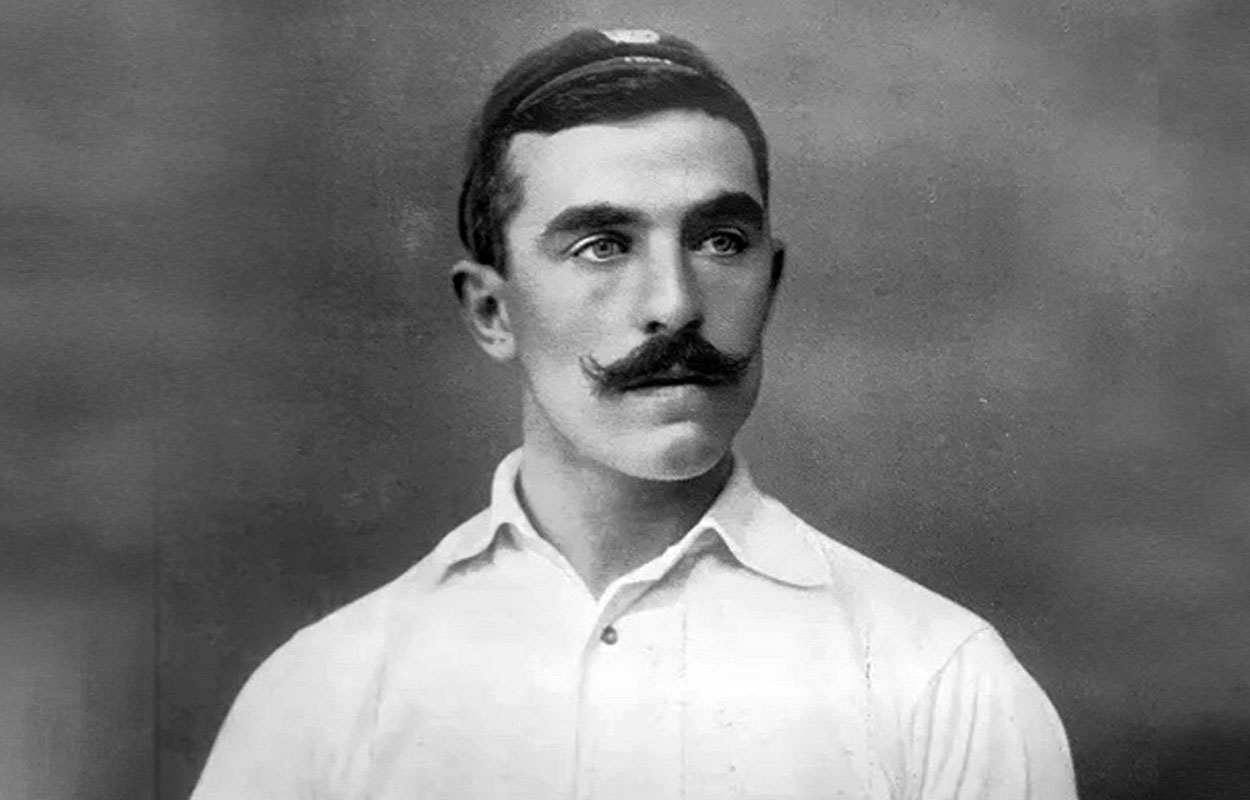
‘His buoyant spirit called for the wild career down the wing, for the flying charge, and the flying shot to the goalmouth where Geary or Chadwick could be trusted to meet the rebound.’
Victor Hall, Liverpool Echo, 1924.
Baines and Pienaar, Dobson and Thomas, Fielding and Eglington, Stevenson and Coulter – all fantastic partnerships on the left side of the Toffees’ attack. The original great partnership on that flank was formed by the contrasting but complimentary attributes of Edgar Chadwick and Alf Milward. Supporters and reporters would refer to them together simply as ‘The Wing’, such was their symbiotic relationship – it was never quite the same if one half of the celebrated twosome missed a match. Their interplay - and effective supply line to Fred Geary - was a huge factor in Everton landing its very first Football League title in 1891 and becoming firmly established as one of the big guns in the last decade of the 19th Century.
Edgar Chadwick, as with several Everton stars of their era (take a bow Johnny Holt and Jack Southworth), hailed from Blackburn. A highly skilled inside-left with superb control of the ball, allied to wonderful vision and dribbling prowess, made 300 appearances (scoring 104 goals) for the Merseysiders over a decade of immaculate service and earned seven England caps. He followed his time at Anfield and Goodison Park with spells with several league clubs in the Northwest, a sojourn on the south coast and a coaching career in mainland Europe.
However, this article focuses on his wing-man, Alf Milward. Atypical for the Toffees in this era, Milward was a Southerner. Born on 12 October 1870 in Great Marlow, Buckinghamshire, he was one of six children born to John (a baker and corn dealer) and Margaret Milward. Having attended Sir William Borlas's Grammar School, he went on to play football for the Old Borlasians FC. Subsequently, the teenager combined turning out as a centre-forward for Great Marlow FC with work as a butcher’s boy. In September 1888 he moved north to throw in his lot with Everton, who would be getting their first Football League campaign underway.
Not quite yet 18, the new recruit was given a few opportunities in the first side during that first season. The excellence of Fred Geary in Milward’s preferred central striking role precluded regular selection for the Toffeemen. He would make six appearances, five of which were at centre-forward, scoring twice.
George Farmer, one of Everton’s first professional players, had been an early idol of the Toffees’ supporters, thanks to his dazzling performances on the left of the attack. However, his time as a regular on the wing was coming to its close. Come the start of the 1889/90 season Milward was tried in the outside-left position and made it his own. Edgar Chadwick was already fully established as the inside-left forward and the Chadwick-Milward double-act soon blossomed, bringing out the best in both. 26 league and cup appearances on the flank that season yielded Milward a remarkable 14 goals (10 league, 4 FA Cup – of which 3 came in a 11-2 defeat of Derby County). The following season, he was an ever-present with a league goal tally of 11 as the Toffees advanced on the title. Two particular goals stood out that season – both against Accrington. One was a winner (from a Chadwick assist) in the trip to East Lancashire in September. In the return match at Anfield, played on Boxing Day, he was switched to centre-forward when Fred Geary was injured during the second half. With the scores level at 2-2, he picked the ball up, surged forward and drove it home from the edge of the box. In doing so, he secured the two vital points and got the side back on track after an indifferent run of results. The Birmingham Post wrote: ‘Milward gained a grand goal, midst tremendous cheerings.’
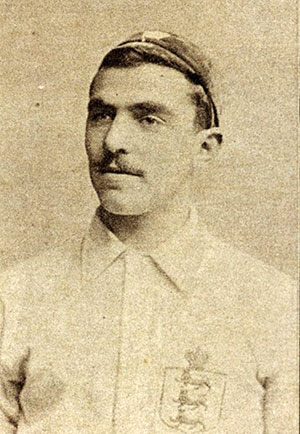
Alf Milward of England
Milward’s brilliance at club level was rewarded with a modest four appearances for England. The first came in March 1891, a 4-1 defeat of Wales (played at Sunderland) in which he and Chadwick became the joint third/fourth Everton players to represent England. Both would find the net – as would future Toffeeman Jack Southworth. His third England appearance, in 1897, would be marked by a brace of goals against Wales. Three days later his England career concluded with a 2-1 defeat to Scotland. In April 1896 he scored at Goodison Park for the Football League select XI in a match against their Scottish counterparts. That same month, he repeated the scoring feat at Ibrox when playing for an ‘English XI’.
Looking back on Milward’s career, some years later, Victor Hall, writing for the Liverpool Echo, eulogised about the Marlow-born forward, who exhibited some of the toughness that fellow wide man John Morrissey would exude in the 1960s:
‘On the field of play itself Alf was a striking personality. He carried himself with an air of confidence. Without boast or affectation, he wore that air of reliance that is, in itself, an asset, to the individual as to the team. Where the genial Edgar [Chadwick] was free in style and stance, Alfred was spruce and debonair. His tunic and shorts might have been the creation of a Bond Street tailor, but the man inside had the tenacity of a bull terrier, and woe to the opponent who mistook the bull for a bear and ruffled him accordingly. AIf Milward had a style of play that was captivating, and an address that was at once engaging and aggressive.
‘Nothing was more entertaining to the club's spectators than to see Milward at full gallop down the touch-line, his arms whirling in a mad ecstasy of sheer delight. Other outside-lefts of his day were certain faster in the sprint - Fred Spiksley of Sheffield, for example, but they were essentially speed-merchants, and hugged the touch-line for their best displays...With Milward, on the contrary, his speed was used only in the resort when the combination of his wing play with Chadwick demanded that he should either make direct for goal himself, either with the ball or to receive Chadwick's forward pass, or that in the alternative the time was opportune for him to take the ball to the corner-post and draw the opponents after him there, while he would then "centre" to his own uncovered inside-forwards.’
According to Hall, although he would defend, when the moment demanded it, the outside-left’s obsession was with attacking football, with him at the heart of it:
‘Milward was impatient of any delay that prevented his side from attacking. To his understanding, the one thing his side had to do was to score goals. To do this they must get the ball and get ahead with it. If, by any chance, the other side got the ball and started an attack of their own, to Alf's mind that was very annoying in so far that it prevented Everton and his wing from getting on with their game, and he showed his disgust unmistakably. It must not be thought from this, that he shirked or neglected defensive work when necessary. On the contrary, he would fall back when pressure necessitated it, and under stress he covered backs…but he was not a natural defender.’
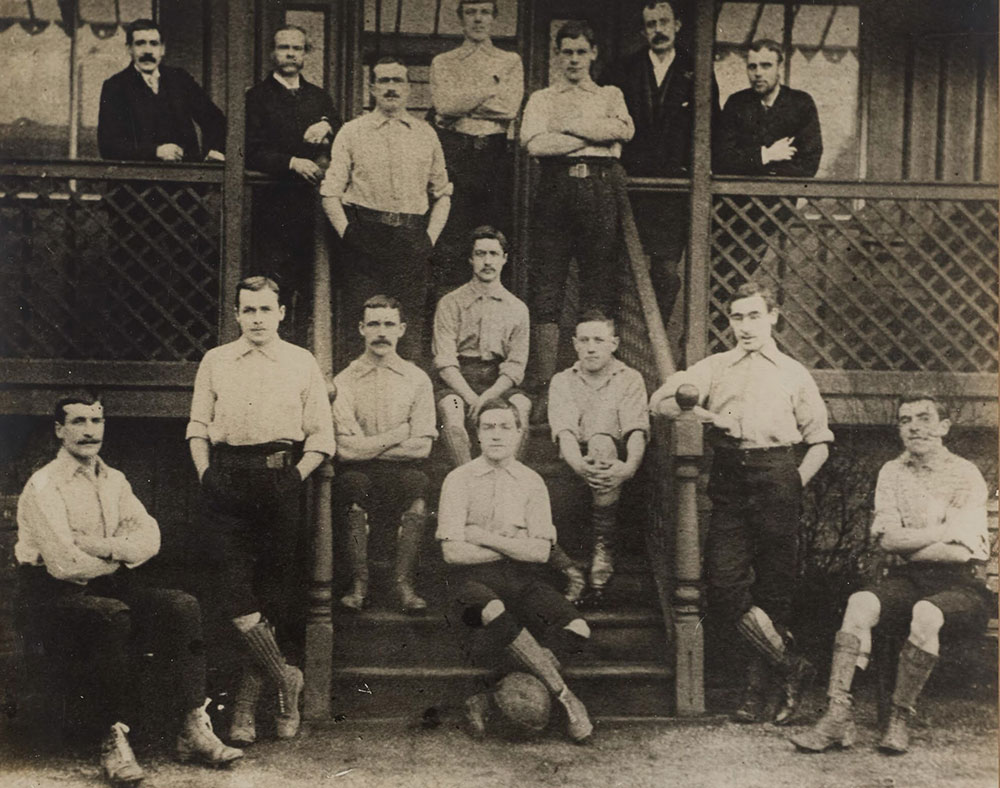
Everton's 1890-91 team with Alf far right front
The on-pitch relationship with the quieter Chadwick was one of mutual respect and near-telepathy. Milward was an immense admirer of his partner; it was said that, for him, no player could hold a candle to Chadwick. Although both could capably head the ball, they preferred it at their feet to better hurt the opposition. Victor Hall recalled:
‘In the roar of an exciting game, when feelings were wrought, and shouting of players and spectators alike were confusing to the ear, the loud shrill voice of Milward might be heard above the din as he raced to get into position for Chadwick's pass. “Now, Edgar!" - his Cockney pronunciation of Edgar's name was unmistakable and signaled effectually, so that the faithful Edgar need never raise his eyes to look for the waiting partner's position. The voice signaled it, and - sure enough - the pass came true.’
Complimentary though their styles were, Chadwick was described as a natural dribbler, whereas the Great Marlow man was a ‘fighter’. ‘He fought to get the ball and fought twice as hard to keep.’ was how Hall described the pugnacious wingman’s attitude. Of course, this was not a two-man team – the outside and inside lefts blended supremely well with Geary (the offensive pivot), Alec Latta and Alec Brady (on the right side of the forward line) and Johnny Holt (the defensive pivot).
Evidence of the Milward ‘fighting spirit’ came in a Merseyside derby at Anfield in November 1896, (by then, home to Liverpool FC). After a goalmouth melee, the Everton man was given his marching orders for barging into the Reds’ John McCartney (the first dismissal in an Everton-Liverpool fixture). He was subsequently suspended for seven days for his transgression (in his defence, he cited provocation).
A charismatic on-field presence was matched by his strong personality when not playing the sport that he loved. His humour and lust for life shone through, as evidenced by Victor Hall’s recollection of ‘a light- hearted, merry soul in himself. Jovial in spirits, fond of song or story; his personality was joyous, and on train journey or in smokeroom, the tedium of travel or training was lightened by his presence. Of his jokes, practical but harmless, there was no end, of his yarns and experiences one could fill book.’
In 1893, a Liverpool Echo writer dubbed ‘Mr. Pathfinder’ was conducting a series of interviews with the local football stars. The most elusive proved to be Milward, but the scribe eventually cornered his prey in a tobacconist shop close to the Sandon Hotel in Anfield. A ten-minute chat ensued, with the man the journalist described as a ‘sturdy limbed fellow.’ Commenting on the forward’s Great Marlow background he added: ‘He is in breeding and manners much above the average football pro. and has always been particularly well liked by the Everton followers.’ When asked of the relative merits of players from the North and South, Milward was blunt: ‘There is no comparison far and away the best, the Northerners are.’ Commenting on the Toffees’ patchy form at that time, he stated: ‘Perhaps there has been a little too much changing places amongst the players, and this may have something to do with it. As at present constituted, Everton is a good team, and will not be long before getting into first class form again.’ The interview wrapped up with Milward confessing to being a keen cyclist and admitting that he was looking forward to a (long service) benefit match the following year (he hoped that Liverpool would be the opponents in the match selected).
In June of that year, the 22- year-old had tied the knot with Belfast-born Catherine 'Cassie' Airey at the Holy Trinity Church in Walton Breck. He gave his address as 50 Oakfield Road and, although now a famous professional footballer, still listed his occupation as a butcher. The marriage would produce three children, all daughters, Phyllis (1894), Cassie (1895) and Edina (1898). By 1898, the family was residing at Bishop Road in Anfield.
Having tasted glory in 1890/91 and made the move from Anfield to Goodison Park a year later, Milward’s left-flank partnership with Chadwick continued, undimmed. Further silverware, however, proved to be frustrating elusive. In 1895 the Toffees finished as runners-up in the League to Sunderland while there were FA Cup final defeats to Wolves and Aston Villa in 1893 and 1897. The defeat to Villa, at the Crystal Palace stadium, signaled that his first team career was reaching its conclusion. Three league wins (and two goals for Milward) wrapped up the season, but behind the scenes, there were ructions.
A ridiculously congested fixture list had seen tensions between players and club directors reach breaking point. After a convincing home defeat of West Bromwich Albion on Saturday 17 April, (Milward and Chadwick both scoring in a 6-3 win), they played a ‘friendly’ against Liverpool on Easter Monday – a bruising contest, in the best traditions of a local derby. The very next day, the side took on Derby (away) in the penultimate league fixture of the season. The physical encounter saw both Johnny Holt and Edgar Chadwick off the pitch for several minutes, receiving treatment, but they battled to a 1-0 win. There was to be no time for recuperation, however, as they boarded a train bound for London, in anticipation of exhibition matches to be played on consecutive days against Reading and Tottenham. In the team’s hotel, harsh words were exchanged between players and officials over the fixture schedule, before a decidedly sub-par Toffees display against the Biscuitmen. For the Spurs game, an exhausted Milward refused, point blank, to play in the 2-1 defeat.
The Liverpool Mercury recorded:
Perhaps it would be kinder to draw a veil over the [Reading] game, and that against Tottenham on the following day…The display at Reading was very moderate and that at Tottenham simply unworthy of any club with a pretension at all to play the game, and the trip from a football point of view must be recorded as one of the black spots on the Everton record.
Milward was summarily suspended by the club directors, appearing before them a few days later. Having offered an apology for his outburst in London, he received a reprimand and warning as to his future conduct. The suspension was then ended and his wages were paid.
However, this episode must have cut deep and come the spring, while still at the height of his powers, Milward walked away from Goodison. It could be more apt to state that sailed away – crossing the Mersey to join New Brighton Tower (along with the Toffees’ left back, Smart Arridge). This ambitious new club was aiming for Football League status, so Everton (still holding Milward’s Football League registration) received no transfer fee for their new star. He collected a £60 signing on fee (Everton would countenance no such largesse), so he was well compensated for dropping out of top flight football.
Back across the water, the so-called ’players’ revolt’ in London and Milward’s defection to New Brighton were hot topics at the Everton AGM. In a febrile atmosphere, more than one shareholder berated the directors for allowing the situation to develop. The London trip was described as ‘a disgrace’ which brought ‘brought discredit on the Everton Football Club.’ ‘Bad management’ was cited and it was pointed out that the crazy schedule had forced Milward to forfeit his chances of playing for England in Glasgow. The board members doubled-down, accusing a couple of players of causing a ‘riot’. They put Milward’s departure down to the financial incentives offered by his new employers rather than any discontent at Goodison Park – the truth was probably somewhere in the middle.
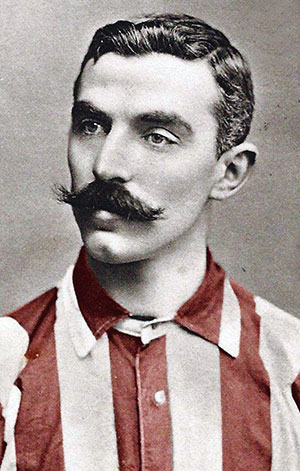
Alf Milward at Southampton (courtesy of saintsplayers.co.uk)
When the 1897/98 season kicked-off, it was John Bell who occupied the outside-left position for Everton. The Scot was a supremely versatile forward, equally adept on either wing or in his preferred inside-forward position. Like Chadwick, Bell had an aura and confidence to match his ability, and struck fear into full-backs. He would strike up an excellent partnership with Chadwick, if never quite reaching the understanding the Blackburnian shared with his old pal.
New Brighton would fail to gain election to the Football league in 1897, but, having won the Lancashire League title, joined the Second Division in the summer of 1898. Milward made 33 Football League and cup appearances, scoring a remarkable 20 goals, but promotion to the top flight was not achieved. At this point, Milward chose to return south, joining Southern League club Southampton. Ironically, he was replaced at New Brighton Tower by John Bell, the Scot having fallen out with the Toffees over his union activities. New Brighton would fold a year later, as Wirral residents failed to flock to watch the new club in sufficient numbers.
Signing for Southampton in the spring of 1899, Milward would complete two seasons with the Saints. In his first campaign he scored 23 goals in 28 Southern League appearances, as the club secured the title. Edgar Chadwick would join his old buddy in red and white stripes in 1900 – and was listed as Milward’s lodger in Shirley, Hants, when the 1901 Census was taken. Back in tandem, the attacking pair helped the Saints to the Southern League title in 1901. Now the wrong side of 30, Milward then threw in his lot with Kentish side New Brompton FC (later to become Gillingham FC), contributing 20 goals over two seasons. He then pitched up at Reading FC – quite possibly through a connection with former Everton teammate Johnny Holt, who had joined the Berkshire side a few years previously. It would be a short-lived spell - a knee injury within a week of signing in October 1903, kept him out for several months, but he was playing for the first team just before Christmas (described in the press as a ‘sterling display’) and into the New Year.
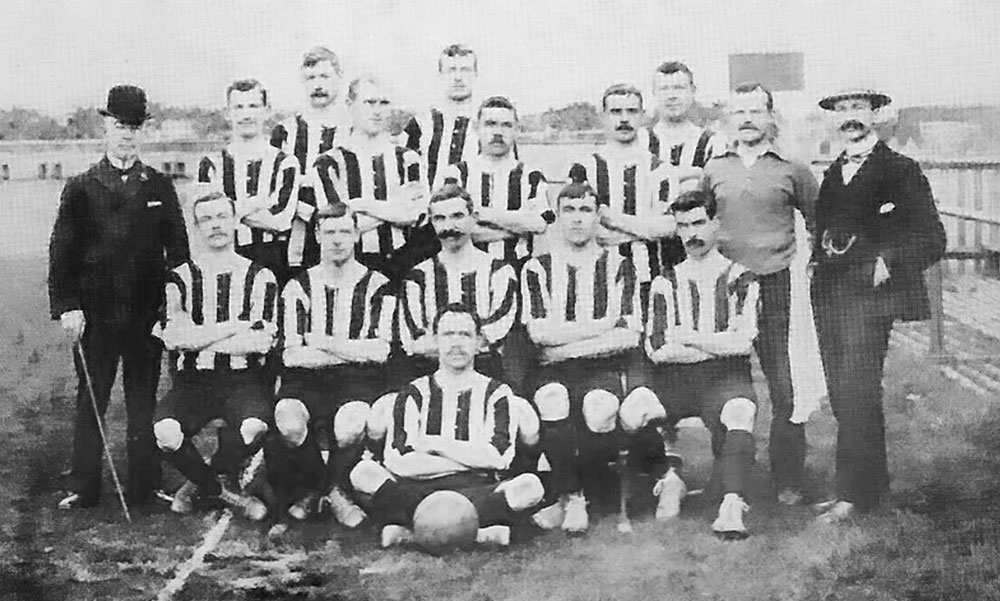
New Brompton 1902-03, with Alf Milward seated centrally
He became a match official for the Southern League when his playing days wound down.
He continued to play football, now in a deeper role, with Southampton Cambridge FC, a local club in the Southampton Junior League. Any bad blood over his departure from Everton had dissipated and, in 1906, he recommended right back Percy Hill to his former club (Hill would go on to make 16 appearances for the Blues).
Income after football came from the pub trade, as was so often the case for former players. In his case it was the Coach & Horses (apparently also known as the Diamon Jubilee, at some point) at 65 Orchard Lane in Southampton. Family accounts, handed down, have Alf Milward as a strong personality and an equally strong man. In addition to his publican duties, he also worked as a sort of bodyguard for the local Conservative Party association. His role was to be on-hand for political rallies, which by all accounts resulted in robust debates with considerable heckling! Given that his pub was in the heart of the 'docks' district with a dominant blue-collar community, one wonders where his political sympathies lay. Perhaps he was a Tory, or was merely happy to be renumerated by the local Conservative Association, for his ‘muscle’?
The 1939 Register (taken at the start of the Second World War), had Milward listed as a ‘general painter and labourer’, still living with Cahterine, but now at 55 Arthur Road, close to The Dell.
Milward’s grandson, Jeff, had a childhood recollection of there being an early morning knock on the door following the night’s bombing during the Second World War. He opened it to find an unrecognisable man facing him, covered in plaster dust from head to foot. He only realised who it was when his grandfather managed to open his stinging eyes. Within a year, Alf Milward was dead. He died on 1 June 1941.
I will end with Victor Hill’s superb description in the Echo of the Everton side which won the Football League in 1890/91, with Alf Milward and Edgar Chadwick at the fore:
None of them were star artistes when they came together first. They were young aspirants for fortune's favours, and the charm about their association together was that they made good together - one helped to make the other. All worked for the common good, and in doing so found their own good fortune together. May it always be so!
Sources and Acknowledgments
Dave Hedgcock
evertoncollection.org.uk
bluecorrespondent.co.uk (newspaper report transcriptions by Billy Smith)
evertonresults.com
englandfootballonline.com
saintsplayers.co.uk (Duncan Holley) – inc. photo of Milward in Southampton kit.
findmypast.co.uk
playupliverpool.com
The Everton Encyclopedia (James Corbett)
Everton: The Official Complete Record (Steve Johnson)
Everton FC 1890/91: The First Kings of Anfield (Mark Metcalf)
Reader Comments (6)
Note: the following content is not moderated or vetted by the site owners at the time of submission. Comments are the responsibility of the poster. Disclaimer ()
2 Posted 02/05/2024 at 00:51:17
Kudos for the information, facts and photos. This must have taken some time to prepare. Brilliant work.
3 Posted 02/05/2024 at 08:31:37
I'm sure generations will cite wingers Everton have had over the years. For me, Trevor Steven.
Kevin Sheedy, although I feel he was better in what we now call the Number 10 role.
Andrei Kanchelskis. And I always feel Anders Limpar is overlooked for his short time at Everton. Quality player.
The Baines and Pienaar partnership was great to watch.
The role of the winger has changed. A lot now tend to play on their opposite foot, if that makes sense. They cut inside as opposed to the traditional hitting the byline and whipping it in.
If you are at St Luke's, let me know. It would be nice to meet you.
4 Posted 02/05/2024 at 09:02:49
5 Posted 02/05/2024 at 11:58:16
6 Posted 04/05/2024 at 11:47:56
Add Your Comments
In order to post a comment, you need to be logged in as a registered user of the site.
Or Sign up as a ToffeeWeb Member — it's free, takes just a few minutes and will allow you to post your comments on articles and Talking Points submissions across the site.
How to get rid of these ads and support TW





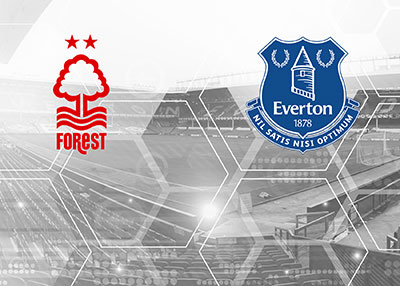





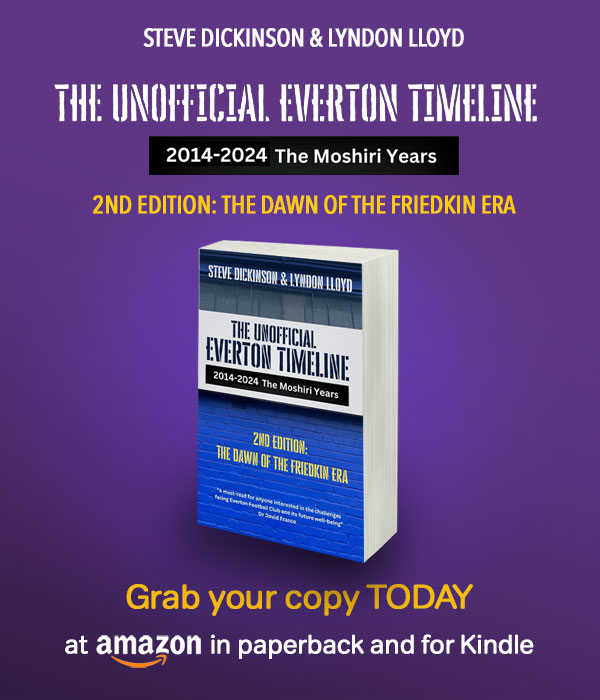
1 Posted 01/05/2024 at 22:35:15